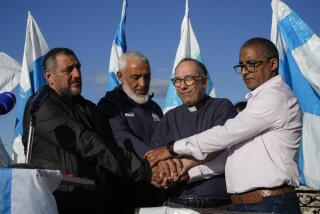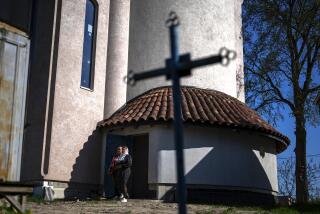Bosnians Still Struggle to Bridge Divide Left by War
- Share via
Until it was bombed to smithereens a decade ago during the Bosnian war, the Stari Most bridge in Mostar was widely regarded as a triumph of architecture and a symbol of peace. The 4-century-old stone bridge arched over the Neretva River in a single, graceful span. Though Muslims mainly lived on one side and Catholics, Greek Orthodox and a handful of Jews on the other, as they had for centuries, ethnic animosity was a rarity. Religious differences apparently mattered so little that the city had more interfaith marriages than any other in the former Yugoslavia. The city emblematized urbanity, tolerance, diversity, pluralism.
But the terrible events that unfolded in Mostar shattered that idyll. At the outset of the Balkans war in 1992, Bosnians joined Croats to defend their homelands against Serbian attacks; and then in the spring of 1993, Croats turned on their erstwhile Muslim allies. Weak Bosnia was carved up by Croatia and Serbia like a Christmas turkey, and the battles in Mostar were among the bloodiest of this famously cruel war.
Neighbors turned on neighbors, family members on one another. “What was so savage is that many of them had been at the same school. And there’s no savagery like fighting your ex-classmate,” says Michael Ignatieff, author of “The Warrior’s Honor: Ethnic War and the Modern Conscience.”
More than 5,000 people were killed or wounded, untold numbers of women were raped and nearly half of the city’s 120,000 residents were forced to flee their homes.
Mostar’s smashed bridge, a carefully chosen target, came to symbolize the new disorder -- the resurrection of ancient animosities, the triumph of tribalism over the transcendent dream.
A Croatian journalist named Slavenka Drakulic wrote in the London Observer that she felt “more pain looking at the image of ... the destroyed bridge than the image of a murdered woman.... We expect people to die. We count on our own lives to end. The destruction of the monument of civilization is something else. The bridge, in all its beauty and grace, was built to outlive us; it was an attempt to grasp eternity. Because it was the product of both individual creativity and collective experience, it transcended our individual destiny. A dead woman is one of us -- but the bridge is all of us forever.”
Before the war, tourists flocked to an elegant city of fine stone buildings and lovely parks. Just 15 miles away lies Medjugorje, where six youths claimed to have seen apparitions of the Virgin Mary beginning in 1981. Busloads of pilgrims used to stay in Mostar’s hotels. But even though the war formally ended in 1995, the crowds haven’t returned. In recent years, there has been sporadic rioting -- sometimes instigated by the police themselves -- and orchestrated attacks on peacekeepers. The risk of renewed violence is sufficient to warrant the continued presence of NATO soldiers.
Visitors who do make their way to Mostar book rooms at characterless modern hotels because the old hotels are ghost palaces, their roofs imploded, their exteriors filigreed with holes made by mortar shells. So are all the other fine stone buildings, palaces and monasteries and mosques -- not leveled, as typically happens in wartime, but taken out one by one, as if someone were settling a personal score against the balconies and doorways, in a scale unequaled anywhere else in Bosnia.
Nearly every building of real historic value or architectural merit was the object of pinpoint enemy fire. A website sponsored by the World Monument Fund quotes a soldier explaining why he splattered the walls of a 16th century Ottoman mosque with automatic weapons fire: “If you destroy their mosques,” the young man says, “they never come back.”
The parks in Mostar have vanished as well. Every one of them was converted into a cemetery, and almost every gravestone is marked by a single year: 1993.
Still, there are signs of revival. A cathedral and several mosques have been built, as well as a synagogue, constructed entirely of glass as a hopeful symbol of faith in the future. There are also hints of swords-into-plowshares capitalism. Tourist shops sell T-shirts with drawings of the old bridge as well as brass shell casings from the war, now adorned with decorative carvings.
Refugees, some of whom were resettled in the United States after the war, are returning as well, reclaiming their old apartments, living in uneasy proximity to their wartime tormentors.
After all the bloodshed, can the old dream of peace finally be realized?
Bosnia no longer makes news, for the world’s attention long ago shifted to other atrocities, but in Mostar, people are still picking up the pieces. Recently, the keystone was hoisted onto the old stone bridge, resurrecting its arch. It was a fine moment, but history is unkind to optimists in this part of the world. On the brow of a nearby hill a mammoth cross, erected by the Croatian government ostensibly to honor all the war dead, looms over the damaged city. At the right time of day, its shadow engulfs the minaret of the mosque.
David L. Kirp, professor of public policy at UC Berkeley, is the author of “Shakespeare, Einstein, and the Bottom Line: The Marketing of Higher Education” (Harvard University Press, 2003).
More to Read
Sign up for Essential California
The most important California stories and recommendations in your inbox every morning.
You may occasionally receive promotional content from the Los Angeles Times.













